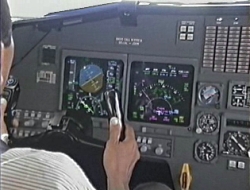PRELIMINARY REPORT
As the flight neared Dubai, the crew received the automatic terminal information service (ATIS) Information Zulu, which included a windshear warning for all runways.
The Aircraft was configured for landing with the flaps set to 30, and approach speed selected of 152 knots (VREF + 5) indicated airspeed (IAS) The Aircraft was vectored for an area navigation (RNAV/GNSS) approach to runway 12L. Air traffic control cleared the flight to land, with the wind reported to be from 340 degrees at 11 knots, and to vacate the runway via taxiway Mike 9.
During the approach, at 0836:00, with the autothrottle system in SPEED mode, as the Aircraft descended through a radio altitude (RA) of 1,100 feet, at 152 knots IAS, the wind direction started to change from a headwind component of 8 knots to a tailwind component. The autopilot was disengaged at approximately 920 feet RA and the approach continued with the autothrottle connected. As the Aircraft descended through 700 feet RA at 0836:22, and at 154 knots IAS, it was subjected to a tailwind component which gradually increased to a maximum of 16 knots.
At 0837:07, 159 knots IAS, 35 feet RA, the PF started to flare the Aircraft. The autothrottle mode transitioned to IDLE and both thrust levers were moving towards the idle position. At 0837:12, 160 knots IAS, and 5 feet RA, five seconds before touchdown, the wind direction again started to change to a headwind.
As recorded by the Aircraft flight data recorder, the weight-on-wheels sensors indicated that the right main landing gear touched down at 0837:17, approximately 1,100 meters from the runway 12L threshold at 162 knots IAS, followed three seconds later by the left main landing gear. The nose landing gear remained in the air.
At 0837:19, the Aircraft runway awareness advisory system (RAAS) aural message “LONG LANDING, LONG LANDING” was annunciated.
At 0837:23, the Aircraft became airborne in an attempt to go-around and was subjected to a headwind component until impact. At 0837:27, the flap lever was moved to the 20 position. Two seconds later the landing gear lever was selected to the UP position. Subsequently, the landing gear unlocked and began to retract.
At 0837:28, the air traffic control tower issued a clearance to continue straight ahead and climb to 4,000 feet. The clearance was read back correctly.
The Aircraft reached a maximum height of approximately 85 feet RA at 134 knots IAS, with the landing gear in transit to the retracted position. The Aircraft then began to sink back onto the runway. Both crewmembers recalled seeing the IAS decreasing and the Copilot called out “Check speed.” At 0837:35, three seconds before impact with the runway, both thrust levers were moved from the idle position to full forward. The autothrottle transition from IDLE to THRUST mode. Approximately one second later, a ground proximity warning system (GPWS) aural warning of “DON’T SINK, DON’T SINK” was annunciated.
One second before impact, both engines started to respond to the thrust lever movement showing an increase in related parameters.
At 0837:38, the Aircraft aft fuselage impacted the runway abeam the November 7 intersection at 125 knots, with a nose-up pitch angle of 9.5 degrees, and at a rate of descent of 900 feet per minute. This was followed by the impact of the engines on the runway. The three landing gears were still in transit to the retracted position. As the Aircraft slid along the runway, the No.2 engine-pylon assembly separated from the right hand (RH) wing. From a runway camera recording, an intense fuel fed fire was observed to start in the area of the damaged No.2 engine-pylon wing attachment area. The Aircraft continued to slide along the runway on the lower fuselage, the outboard RH wing, and the No.1 engine. An incipient fire started on the underside of the No.1 engine.
The Aircraft came to rest adjacent to the Mike 13 taxiway at a magnetic heading of approximately 240 degrees. After the Aircraft came to rest, fire was emanating from the No. 2 engine, the damaged RH engine-pylon wing attachment area and from under the Aircraft fuselage. Approximately one minute after, the Commander transmitted a “MAYDAY” call and informed air traffic control that the Aircraft was being evacuated.








Nenhum comentário:
Postar um comentário